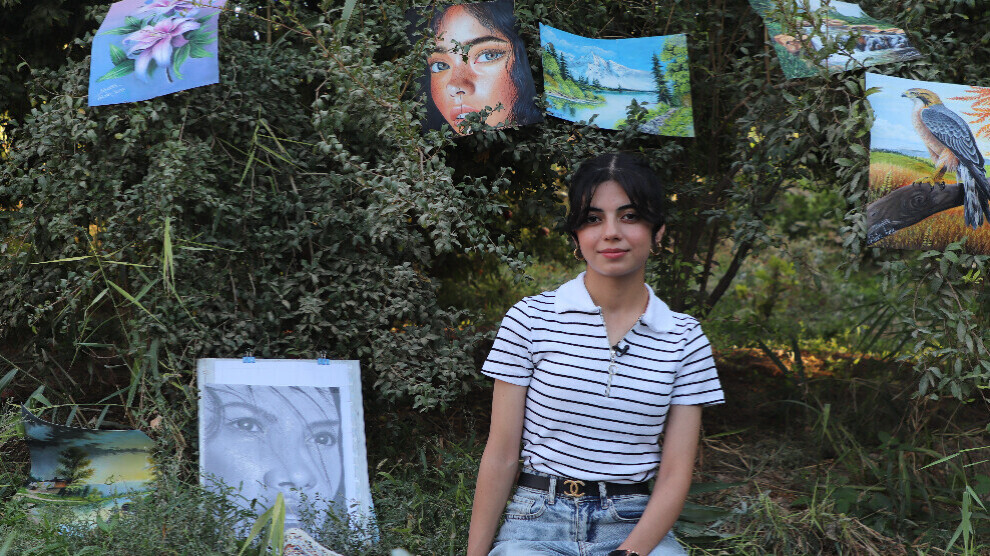Art in the Time of Refuge... How the People of Makhmour Protect Themselves with Colors
Makhmour Camp stands as a model of resistance and resilience despite sieges and attacks, where a talented generation has emerged—expressing their pain and hopes through art. The story of the painter Akhîn Tunc is a vivid example of creativity .

Berîvan Tunc
Makhmour — In a world overflowing with corruption, wars, crises, and chaos, art remains a safe haven to which humans turn to fill the emptiness of their hearts, purify their souls from the impurities of pain, and reconnect with their essence. History proves that humankind has always sought refuge in art, nourished the spirit through it, and searched for identity within its boundless, enchanting realm.
The Martyr Rustem Judy Camp, established 27 years ago after a long and exhausting journey of displacement, was built in the plains of Makhmour at the foot of Mount Qandil, in a harsh environment. Its residents started life from scratch under extremely difficult conditions, yet managed to create a vibrant community full of life and perseverance.
Within this camp, hundreds of talented individuals have been born—expressing their deep emotions through art, embodying both joy and sorrow amid the hardships of refugee life. Among them is Akhîn Tunc, who opened her eyes to life inside the camp and spent her childhood among its tents, alongside children whose families came from villages in Northern Kurdistan. All of them were born in the ongoing exile of the past 27 years, and they grew up as companions along the road of life.
Painter Akhîn Tunc found refuge in drawing amidst sorrow and alienation. She held on to her pencil to sketch the realms of her imagination on paper. Mountains—symbols of freedom deeply rooted in her spirit—are a recurring theme in her work, turning her paintings into mirrors pulsing with life and hope.
She expresses her emotions and thoughts on white paper using only a black pencil, often through portrait art as a way of self-expression:
> “I’ve loved drawing since childhood. I used to enjoy art class at school immensely and always participated enthusiastically. I constantly held a brush in my hand, and my art teachers noticed my passion and encouraged me. In recent years, I’ve devoted all my time to painting. Whenever I find a free moment, I turn to a blank page to draw what I feel—it brings me indescribable joy.”
Art as a Means of Expression
Akhîn also expresses her longing for the mountains, which have always held a symbolic place in Kurdish legends, becoming for over fifty years both a refuge and an inspiration for Kurdish youth. “I tend to focus on portrait painting, aiming to highlight the body’s details and the emotions reflected in each face,” she says. “Yet, I always add a mountain scene in my paintings, because I see in the mountains a beauty that is unmatched—and I strive to capture that beauty in every artwork I create.”
She shed light on the impact of the siege imposed on the children of Makhmour Camp, noting its profound effects on their psychological and educational lives:
“We’ve been living under harsh conditions for years, and we exert great effort to continue our education despite all challenges. But the ongoing blockade, which has lasted for nearly six years, has directly affected the educational process and left deep marks on the children’s minds.”
Akhîn added:
> “I’m now in my final year of high school and dream of studying architecture at university. But for the past five years, no student from the camp has been allowed to enroll in any university, which has created a sense of frustration and despair among us. Many talented and ambitious young people are now forced to work in construction instead of studying. There are so many capable youths in the camp, but the lack of opportunities prevents them from developing their skills and achieving their dreams.”
In conclusion, she called on young people to develop their artistic abilities, emphasizing that art is not limited to drawing:
“Painting is not the only way for a person to express themselves. There are many other forms of art that can be paths to distinction. For example, learning musical instruments allows young people to express their feelings, break the cycle of marginalization, integrate into society, and realize their potential through art. It’s essential to provide more opportunities for talented youth in all artistic fields so they can refine their skills and build their future.”
